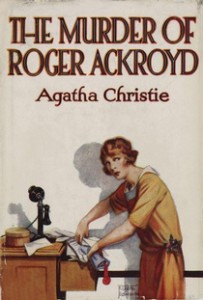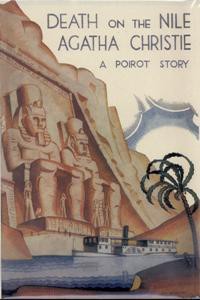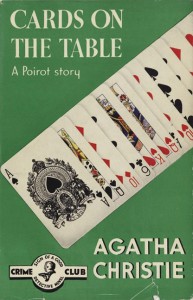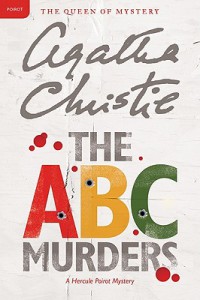10. The Murder of Roger Ackroyd
 “One must always proceed with method. I made an error in judgment in asking you that question. To each man his own knowledge. You could tell me the details of the patient’s appearance – nothing there would escape you. If I wanted information about the papers on that desk, Mr. Raymond would have noticed anything there was to see. To find out about the fire, I must ask the man whose business it is to observe such things.”
“One must always proceed with method. I made an error in judgment in asking you that question. To each man his own knowledge. You could tell me the details of the patient’s appearance – nothing there would escape you. If I wanted information about the papers on that desk, Mr. Raymond would have noticed anything there was to see. To find out about the fire, I must ask the man whose business it is to observe such things.”
In a quiet English village, Mrs. Ferrars, which is said to have killed her husband, dies in unexplained circumstances. Was it suicide or was it poisoning? In a last letter to his alleged lover, Roger Ackroyd, she was revealing that she was the victim of an appalling blackmail. When his body is found there is no room for doubt: the man was killed. Why is it someone wanted to kill Roger?
This one turns out to be a very difficult investigation for Poirot, who makes a list of everyone, family, servants, neighbors, all of those that seemed to have had motives to assassinate the very rich Mr Ackroyd. Fortunately for Poirot, his assistant was there to help him solve this mistery, no one else than the famous doctor Sheppard who was accompanying his investigations and was recording all the details.
This novel is one of the most unexpected and surprising endings of all of Agatha Christie’s work, coming out for the first time in 1926, being categorized as a detective novel as well.
9. Death on the Nile
 “It often seems to me that’s all detective work is, wiping out your false starts and beginning again.”
“It often seems to me that’s all detective work is, wiping out your false starts and beginning again.”
Yes, it is very true, that. And it is just what some people will not do. They conceive a certain theory, and everything has to fit into that theory. If one little fact will not fit it, they throw it aside. But it is always the facts that will not fit in that are significant.”
Linnet Doyle is apparently a being almost incredible, because she seems to have everything a woman would want to have: beauty, wealth, intelligence, charm and … a loving husband. When she is killed, the little and subtle psychologist detective, Hercule Poirot, found by chance in the same trip, sadly discovers all crossfire of interests and passions around the rich heiress tissue.
Agatha Christie’s “Death on the Nile” is considered one of her most successful novels, and critics and audiences did not contradict her. Indeed, in his concise and effective style, the writer offers readers not only intrigue sinuous and seductive, with an unexpected end, but also an exemplary illustration of the essential human dramas and passions.
8. Cards on the Table
 “Do you believe in the value of truth, my dear, or don’t you?”
“Do you believe in the value of truth, my dear, or don’t you?”
“Of course I believe in the truth,” said Rhoda, staring.
“Yes, you say that, but perhaps you haven’t thought about it. The truth hurts sometimes – and destroys one’s illusions.”
“I’d rather have it all the same.” said Rhoda.
“So would I. But I don’t know that we’re wise.”
The action of the book begins with an ordinary evening of bridge that turns into a murder investigation because of the death of the host. Four of the guests are suspects because they were in the same room with the host and each had the opportunity to kill her.
The suspects are interrogated by Commissioner Battle, aided by Colonel Race and Mrs Oliver. Commissioner Battle visited them all asking questions about their past. Meredith Anne of all suspects only failed to talk about the last two months of her life, but her friend Rhoda Dawes, Mrs. Oliver, tells him everything.
Possible Killers
“ Each guest had the opportunity to kill her ”
Poirot makes a visit to each of the suspects asking them questions at first sight strange, but which tended to find their true character, in order to find out who would be able to commit the murder.
Poirot also finds out an important moment in the history of Major Despard, when he accidentally killed a man. Finally, with his cunning characteristic methods, or as he liked to say, with “Hercule Poirot’s gray matter“, he discovers the killer. The main character is Hercule Poirot, a detective who has special methods to catch criminals, methods resembling those used by Sherlock Holmes.
Secondary characters are: Dr. Roberts, one of the suspects and the three people on suspicion of poisoning, Anne Meredith, suspect and one of the possible killers, old Major Despard, a suspect that in the past killed a man accidentally, Mrs. Lorrmer, a suspected who killed her husband in the past, Commissioner Battle, one of the most important secondary characters, who helped unmask the killer by interrogating the suspects, Mrs. Oliver and Colonel Race who helped to catch the killer and Rhoda Dawes, Meredith’s friend, who almost was killed by her.
The meaning is clear from the last chapter title in which Hercules Poirot tells how he managed to find the killer, in other words, to “throw the cards on the table“.
7. The A.B.C. Murders
 “Death, mademoiselle, unfortunately creates a prejudice. A prejudice in favour of the deceased. I heard what you said just now to my friend Hastings. ‘A nice bright girl with no men friends’. You said that in mockery of the newspapers. And it is very true—when a young girl is dead, that is the kind of thing that is said. She was bright. She was happy. She was sweet-tempered. She had not a care in the world. She had no undesirable acquaintances. There is a great charity always to the dead. Do you know what I should like this minute? I should like to find someone who knew Elizabeth Barnard and who does not know she is dead! Then, perhaps, I should hear what is useful to me—the truth.”
“Death, mademoiselle, unfortunately creates a prejudice. A prejudice in favour of the deceased. I heard what you said just now to my friend Hastings. ‘A nice bright girl with no men friends’. You said that in mockery of the newspapers. And it is very true—when a young girl is dead, that is the kind of thing that is said. She was bright. She was happy. She was sweet-tempered. She had not a care in the world. She had no undesirable acquaintances. There is a great charity always to the dead. Do you know what I should like this minute? I should like to find someone who knew Elizabeth Barnard and who does not know she is dead! Then, perhaps, I should hear what is useful to me—the truth.”
“The A.B.C. Murders” is a detective novel written in 1936. In this book, Agatha Christie released the little Belgian, a detective with a huge mustache, Hercule Poirot, known for his genius and passion for the psychological cases. This book proves to be one of the only ones that truly deserves the statement Aghata Christie said: ,,identify the person least likely to have committed a murder and, in nine cases out of ten, your task is over.“
And indeed, the answer is not evident this time, any more than it was in other times either. For the first time in the entire collection of books by Agatha Christie, we are dealing with a serial killer. It all starts with a letter written by the mysterious ABC, for Poirot, in which he is announcing that on the 21 of the month, in Andover , there will be a crime.
The unfortunate person is Ms. Ascher but no one believes that the culprit could be the writer. When the crime is repeated in Bexhill-on-Sea and the victim is Miss Barnard, the fear of Poirot is as it follows, other 24 murders taking place as well.

